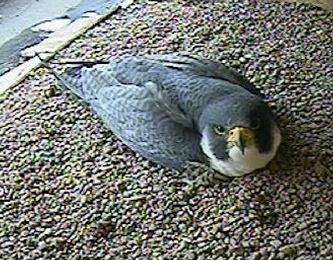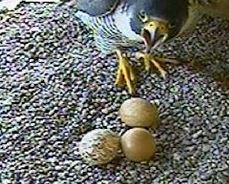Peregrine Falcons are Back at Charing Cross
And happy couple Tom and Charlie are sitting on three eggs
Peregrine falcons, once on the brink of extinction, are nesting at Charing Cross Hospital for the sixth successive year.
A pair of the birds of prey, the fastest animal on the planet, have taken up residence once more on a top ledge on the East Wing of the Fulham Palace Road hospital building and are currently incubating three eggs.
One Fulham resident keeping a close eye on the raptors is Nathalie Mahieu, 49, who runs the FaB (Fulham and Barnes) Peregrines website, as well as Twitter and Facebook accounts, which detail the birds’ behaviour and provide a livefeed via a webcam at the nest.
She says: " The cameras were set up by the hospital initially. It was so that we could monitor the birds and their eventual breeding without disturbing them. It also allowed us to observe without drawing too much attention to them and their exact location.
" Peregrine Falcons are protected by law and you are not to publicise their breeding site unless authorised to do so, but we were authorised by Natural England after their first breeding season here."
Nathalie has been following the peregrines since 2007 when she first spotted the female, which she called Charlie (named after the 'Char' of Charing), landing on the hospital.
Charlie has paired with two males since first nesting at the site in 2010. That first year the pair were unsuccessful, but the hospital, together with Dave Morrison of the London Peregrines consultancy, put up a nest box and chicks have successfully fledged every year since.
Charlie paired with one male from 2008-2011, before that bird was ousted by her current partner, called Tom, pictured below.

Peregrine falcons suffered badly from persecution, particularly from landowners and gamekeepers concerned about livestock and the population plummeted during the 1950s with the widespread use of organochloride pesticides. The falcon’s eggs are also a prized favourite of illegal collectors.
Traditionally the birds breed along the west coast of the UK, nesting on high cliff tops, but as the species has recovered through being given protected status and a dedicated conservation effort, the birds have thrived, moving further inland and adopting city high-rises as substitute cliffs, where there is often a plentiful supply of their favourite food – pigeons.
They are now quite regularly seen across the city and there are 1,500 breeding pairs in the UK.
The skilful predators kill their prey by striking them with their talons after a near-vertical stoop, at speeds often approaching 200mph.
The FaB Peregrines Twitter account has more than 1,700 followers and the Facebook page has more than 500 likes with the birds' behaviour on the webcam winning many fans from the borough and beyond.
Such is the interest in the magnificent birds that passers-by often are left in awe when Nathalie lets them watch the birds through her telescope which she often sets up in the Margravine Cemetery during nesting season.
Nathalie says: " They are special because they are charismatic, beautiful birds. Watching them fly can be breath-taking. They are a protected species and a symbol of a successful conservation effort."
Charlie and Tom are currently sitting on three eggs, which if they hatch successfully, should fly the nest around late May to early June.

You can keep track of their progress on FaB Peregrines' website
May 15, 2015
Related links
|
